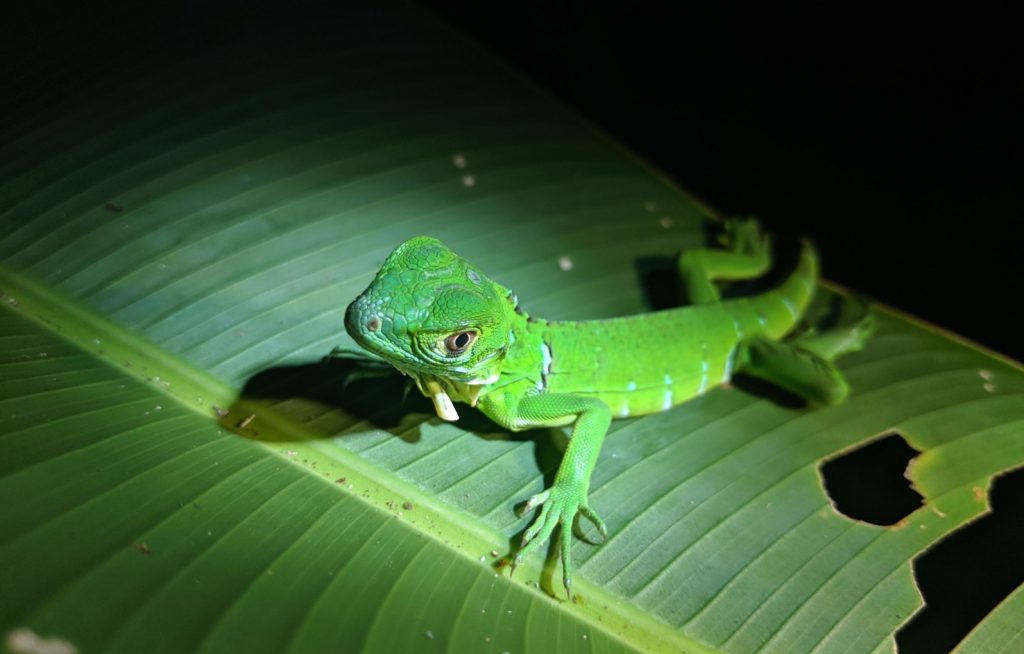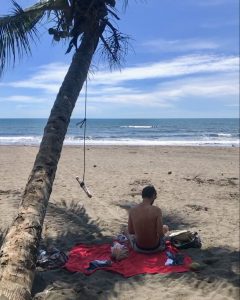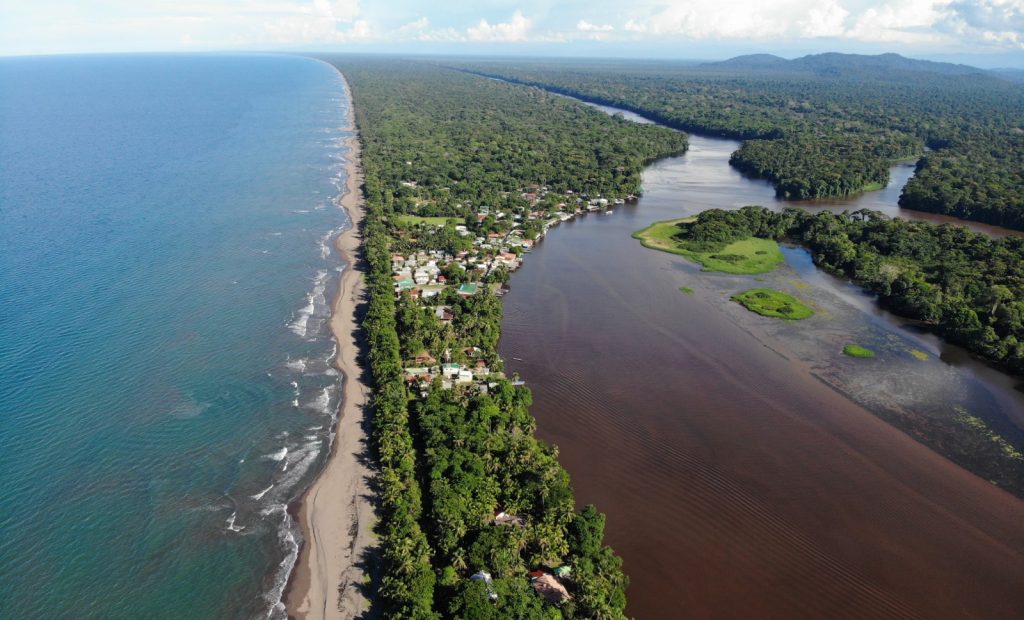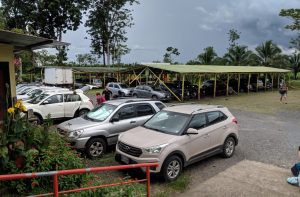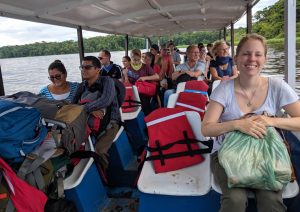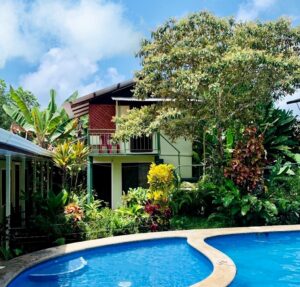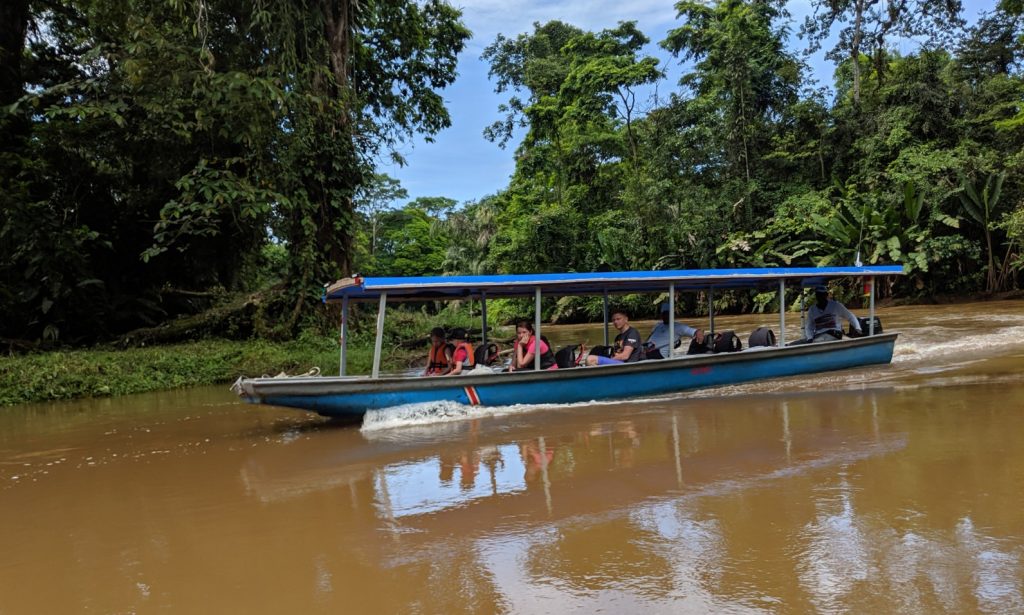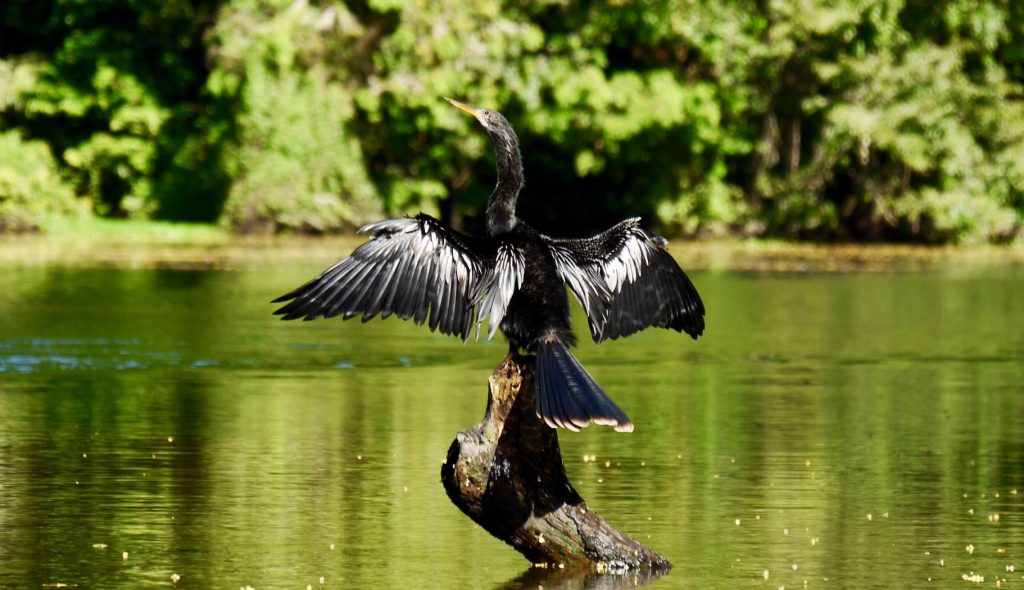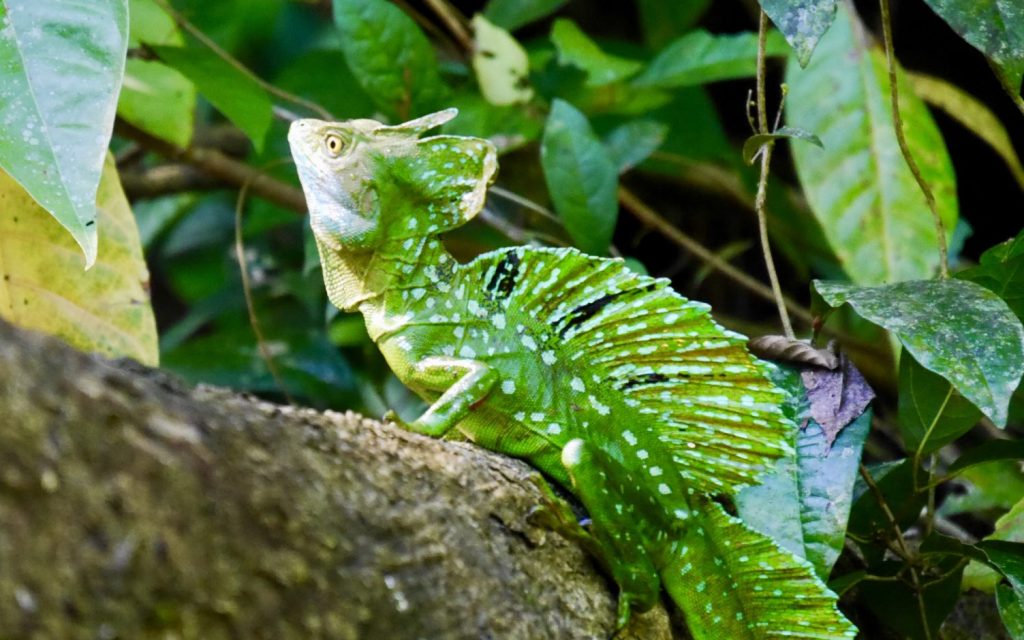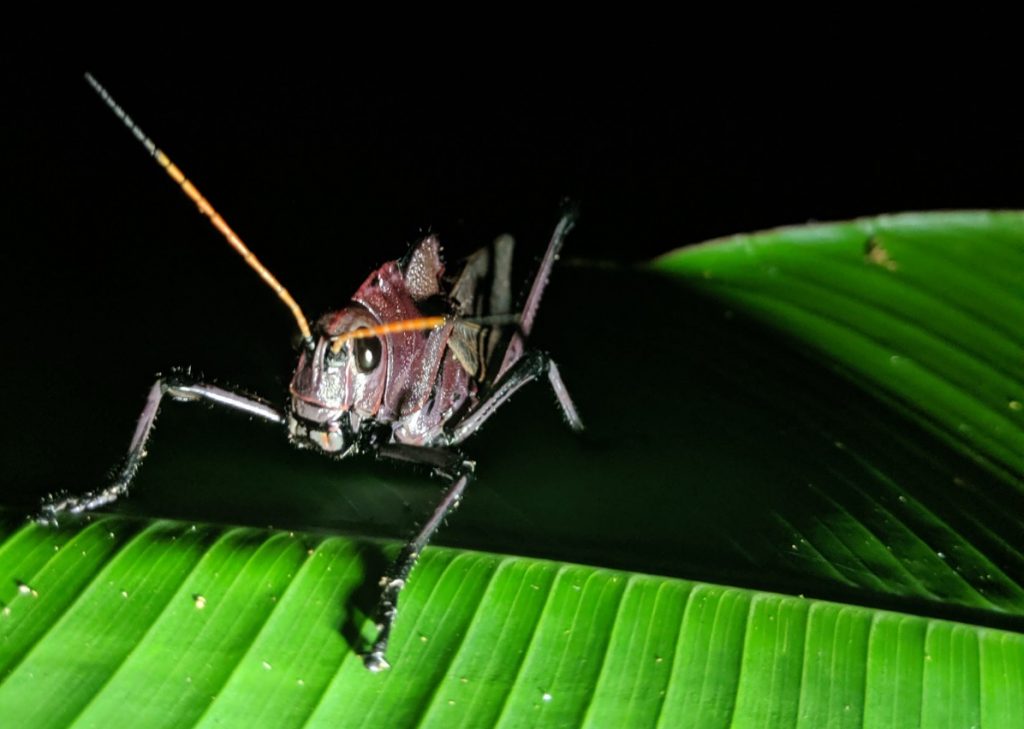The Tortuguero National Park in Costa Rica is one of the best places in this beautiful country. Most of the people visit Tortuguero National Park to see turtles. But should you visit the turtle paradise Tortuguero also in the low season and therefore outside the turtle season? We did a roadtrip in Costa Rica in May/June and thought about whether we should take on the costly journey to the Tortuguero National Park, even though we will not see any egg-laying turtles outside the turtle season. Because the turtles that lay their eggs on the beach are the tourist magnet and the reason why most of the tourists come to Tortuguero.
In this article you will find out why it is worthwhile to go to this remote sandbank on the Caribbean coast in the low season even without turtles.
Facts about the Tortuguero National Park Costa Rica
The Tortuguero National Park covers about 20,000 hectares.It was founded in 1975 and is located in the northeast of Costa Rica on the Caribbean coast. Its canal landscape, which is surrounded by dense rainforest, and its location by the sea makes this place truly unique.
Here you will find a variety of plants and animals that can be found in few other places in Costa Rica. About half of the bird and reptile species living in Costa Rica live here. Sloths, iguanas, caimans, toucans, parrots, many species of monkeys, crocodiles, manatees and over 300 species of birds can be discovered here.
Tortuguero national park opens daily from 6-12 and 13-16 and costs 15 USD entrance fee per person.
The Village of Tortuguero
Tortuguero, the village of the same name as the national park, lies on a narrow sandbank between the Caribbean Sea and the Rio Suerte, only 40 km from the Nicaraguan border. The village and the accommodations can only be reached by boat or plane. About 500 villagers live here mainly from fishing and of course tourism.
The location between the Caribbean Sea and the Rio Suerte makes this spot a very special place. As you can see at the top of the cover picture, in the afternoon you can lie on the beach in the sun and swim in the sea and then walk a few meters over to the river side to watch the sun set behind the Rio Suerte. Where in the world can you do something like that?
By the way, the name Tortuguero means something like “place where the turtles come” and is borrowed from the Spanish word for turtle “tortuga”.
What to do in Tortuguero National Park?
Watch Turtles laying their Eggs
The reason for most tourists to come to Tortuguero is certainly the observation of turtles laying eggs. This is a unique spectacle that can be seen at night on the beach of Tortuguero during most months of the year. For some years now this is only possible with a certified guide. During this tour, for which you have to pay 25 USD, you are not allowed to take photos or videos. You are not allowed to use a flashlight and you have to be dressed in dark clothes. The turtles should not be disturbed while laying their eggs.
Take a tour by Canoe or Kayak through the Canals
That was the highlight of our stay. The canoe or kayak tours usually start at 6 a.m. and take you over 3 hours through the channels of the Rio Suerte in a small part of the National Park Tortuguero. Canoe tours cost about 25-30 USD. You will be in a wooden canoe with up to 9 other people and your guide will take you from animal to animal.
On a kayak tour, which is available for about 30-40 USD, you will paddle in a small kayak with a guide (who has his own kayak). Therefore you not only have a sporty activity in the early morning, but also almost a guarantee that you are alone with your guide (we were at least). Also you can decide for yourself how close you want to paddle and how long you want to marvel and take pictures. Of course this is not so easy on a tour with several people. Since the kayak/canoe tours lead through the national park, there is an additional 15 USD park entrance fee per person.
We were very happy with our kayak tour (which, by the way, we booked directly through our accommodation with Roots Tour). Besides the many interesting information from our guide we also got to see many animals – like water birds, monkeys and a sloth. We were also very happy that the tour took place so early in the morning. Not only are the animals much more active when it is not yet so hot. Of course we humans are as well. When it started to get really hot at 9 am I was glad that the tour was nearing its end.
That was also the reason why we didn’t do another hike during the day, but went on a night hike (Night Hike).
Hiking during the Day or Night
If you have done a canoe trip in the morning, you will usually get your entrance ticket for the park afterwards. With this ticket you can then go to the national park for free on the same day to hike on your own. But we left this out, because a) we were still too exhausted from the heat and the kayak tour in the morning and b) we also heard little good things about the hiking trail in Tortuguero National Park. This is not a round trip but a path that you have to walk back and forth. Moreover, this path is not supposed to be very varied.
If you have the time and the physical condition, you can of course visit the park.
As mentioned above, we booked a Night-Walk (a night or rather evening hike) with Roots Tour in addition to our kayak tour. Unfortunately we were not very happy with it. As the national park is not allowed to be entered at night, the hikes – unless you are accommodated in an expensive lodge with its own hiking trails – take place in the closer surroundings of the village. This means that one does not get far away from the village and also sees the lights of the village while cutting through the bushes. Thereby, unfortunately, there is not much jungle feeling.
We did see some animals, for example two sloths. But we would probably have seen them too, if we had been walking alone through the bushes. Then we would also have saved the 25 USD per person. As you can see, we were not really enthusiastic. We wouldn’t do the tour again and wouldn’t recommend it. Even though it is of course something special to photograph animals only in the light of a flashlight.
Relax on the Beach or Swimming in the Sea
Before our visit we heard that the beach at Tortuguero is closed for swimming because it is too dangerous. So we had already prepared ourselves for hours of sunbathing without being able to refresh ourselves in the sea. But happily this was not the case. Swimming is not forbidden in Tortuguero, it is only very dangerous because of the occurring surf back currents (riptides). They can pull you into the open sea with their strong suction.
But when we were there, you could go into the sea without hesitation. Maybe it was also because of the wonderful weather we had. Inform yourselves at your hotel how the sea is to be estimated currently. Apart from that swimming is not generally forbidden in Tortuguero. At least not in the sea. In Rio Suerte on the other side of the village swimming is not officially forbidden, but you should avoid it because of the crocodiles.
When is the Turtle Season in Tortuguero?
The season is October to March for the loggerhead turtle and leatherback turtle. July to October for the hawksbill turtle and sea turtle. In the rest of the time you will not see turtles, but many other wonderful animals and much less tourists. This makes the Tortuguero National Park also interesting outside the turtle season.
How to get to Tortuguero from San Jose?
You can go to Tortuguero yourself or you can book a Tour for 1-3 days from San Jose*. No matter if you are travelling by rental car or bus, first you have to get to the boat landing stage in La Pavona. From there you can continue by boat to Tortuguero.
Book a Tour to Tortuguero | Check Prices*
How to get to La Pavona by Bus
To get from San Jose to La Pavona you have to change trains in Cariari.
From San Jose to La Pavona
Departure times: 06:30h, 09:00h, 10:30h, 13:00h (there are also later buses, but then you won’t get the last bus to get to La Pavona in time)
Cost: 1800 Colones
Departure times: 05:00h, 09:00h, 11:30h, 15:00h
Costs: The bus driver sold us the ticket to La Pavona and the boat ticket (including luggage) for 5000 Colones per person.
The best way to get from San Jose to Tortuguero
We have taken the following connection to be in Tortuguero as early as possible:
- At 9:00 a.m. we left Gran Terminal de Caribe for Cariari
- At 11:15 a.m. we took the bus from the same terminal in Cariari (directly opposite) to La Pavona.
- In La Pavona the boat started at 13:00 so we arrived in Tortuguero at about 14:00.
How to get to La Pavona by Rental Car
Of course you can also arrive by car if you have rental car for your Costa Rica road trip anyway. From San Jose you drive about 2.5 hours (120 km) to La Pavona. You can park your car at a big parking lot at the boat dock for currently 10 USD per day.
You can’t drive to Tortuguero National Park with your car, because the inhabited sandbank at the sea can only be reached by boat.
How to get from La Pavona to Tortuguero by boat
From La Pavona you have to take the ferry to Tortuguero National Park. This takes about one hour and the journey is an experience itself. Rio Suerte is very narrow at the beginning and winds continuously left and right through the jungle. The boat has to avoid tree trunks and large water plants again and again.
The ride is a real adventure and could actually be sold as an expensive tour. So you really see a lot of nature and maybe also animals on this great boat trip.
The bus ticket from Cariari including the boat ticket (and luggage) cost us 5000 Colones per person. If you buy the ticket in La Pavona first, you pay 1800 Colones + 1000 Colones per luggage.
Direct flight to Tortuguero National Park
If you have little time and a lot of money, you can also fly with Sansa Air directly to Tortuguero National Park. The flight starts 2-3 times a day and costs about 90 USD per person. You can book the flights on the website of Sansa Air.
Our experiences in Tortuguero outside the Turtle Season
During our stay at the end of May in Tortuguero National Park we had, despite the rainy season, bright blue sky and perfect sunshine. This is not supposed to be typical for this small town on the Caribbean coast. It is said to be one of the rainiest in Costa Rica. But we have heard that from almost every place in Costa Rica.
 Hotel Recommendation in Tortuguero National Park
Hotel Recommendation in Tortuguero National Park
We really enjoyed our stay in the Hotel La Casona*. Everything was very comfortable, we could cook some tasty food in the shared kitchen and loved to spend the days in the at the pool, the sea to the hammocks.
Hotel La Casona in Tortuguero*Because our hotel (La Casona*) is quite close to the beach – like almost all hotels in the small town – we could spend a lot of time at the sea, which we hadn’t thought about before. According to our information swimming is forbidden in Tortuguero National Park. That this is not the case was of course very nice. Swimming is dangerous at the huge beach in Tortuguero only because of the occasionally occurring riptides (dangerous undercurrents), but not completely forbidden.
So we spent the first day on the beach and made ourselves something tasty to eat in the evening in our accommodation. We had booked 3 nights in the comfortable La Casona Hotel and therefore no stress to carry out all activities as fast as possible. We also enjoyed the slowness and Caribbean calmness while strolling through the small village.
So our activity for the second day was: leisurely exploring the village while looking for souvenirs, drinking a coconut and simply enjoying the Pura Vida. On day 2 we also spent a lot of time on the beach and enjoyed the good weather. We also planned our activities for the third day. We wanted to do a kayak tour and a night walk in the evening.
Kayak Tour in the Tortuguero National Park
At the meeting point for our kayak trip, which was only about 200 meters away from our accommodation, we arrived at just before 6 am and got a short introduction. There were about 8 other people there. But apparently we were the only ones who wanted to go by kayak. Everyone else went on a canoe trip. So we had a guide all to ourselves. Great!
Guided Tour
Our guide explained a lot about the flora & fauna and about the history of the place and the national park. For example, that the area was used for logging and therefore there is hardly any primary forest left, but almost all of it is regrown secondary forest. Also there are crocodiles and sharks in the river, which is why it is too dangerous to swim in the river.
And still the inhabitants of the village do it, even though a child is said to have died in a fatal accident. By the way, the sharks get into the river through the access to the sea and can survive there, because the water at the beginning of the river mixes with the sea water and is therefore suitable as a habitat for the sharks.
Flora & Fauna
We drove into the canals of the national park and directly got to see extraordinary plants and great animals. We saw a sloth hanging high in the tree and many birds, which held out in angelic pose in the sun, so that their feathers dry. These birds dive into the water during their forays and have to dry their feathers afterwards to be able to fly properly again. A crazy sight.
Another special animal on our trip was the Jesus Christ lizard, which is wonderfully green. They are called so because they can walk short distances over water. But I guess they only do this when they are in danger. But we saw these lizards in a relaxed position and could therefore take good pictures of them.
We could also observe numerous spider monkeys doing gymnastics near the water. It was really a wonderful tour. Even if it was a bit exhausting, since we had to paddle by ourselves all the time. But this way we could always decide by ourselves how fast we were going and how close we wanted to get to the animals.
So you can see that the Tortuguero National Park has enough other animals to offer even outside the turtle season, which makes a visit worthwhile.
The Night Hike
When we had arrived back in the village after more than 3 hours of paddling, we went to the beach again to rest a little. We had planned a hike for the evening, for which we had to be fit again. Unfortunately the night hike was not as special as we had imagined. Because one is not allowed to enter the national park at night, night walks (from 18-20 o’clock) have to take place near the village.
We saw a sloth and also some spiders and grasshoppers from close distance, but not much more. And for that we found the price of 25 USD per person too high. So we could have walked alone with a good flashlight through the paths at the edge of the village and probably would not have seen much less.
Drive back to San Jose
The next morning we set off very early to the jetty to catch the 5 o’clock boat to La Pavona. Since we unfortunately missed the official public boat, we had to take a private taxi boat, which cost us 4000 Colones per person. And if our captain hadn’t had problems with the fill level of his tank and therefore had to turn back to Tortuguero to refuel, we would have taken the 06:30 bus to Cariari. But so we were too late and would have had to wait for the 10 o’clock bus.
Since we urgently wanted to get to San Jose in time (since Andreas wanted to have his drone repaired there) we took a taxi from Cariari (cost: 20 USD). Thanks to the speeding taxi driver we could still get the 9 o’clock bus from Cariari to San Jose and were already in the capital of Costa Rica in the late morning. After having our drone repaired in the local iCon store, we took the 12 o’clock bus to the next stop on our Costa Rica tour: Puerto Viejo on the Caribbean coast.
Read more to Costa Rica
Is Tortuguero worth seeing outside the Turtle Season?
Even though we were sceptical at the beginning if the Tortuguero National Park would be worth the long journey outside the turtle season, it was totally worth it in the end. The remote location of the village in the middle of the jungle and the accessibility only by boat over a river is a highlight in itself. There is no need for turtles anymore. In addition there are much less tourists in the off-season. Of course we liked that very much. Also you can see a lot of other animals, apart from the famous turtles.
We can only recommend to go to this small natural paradise on the Caribbean coast. Even if there are no turtles to be seen. You will not regret it.
Do you have other experiences out of season in Tortuguero National Park or questions about our experiences? Leave us a comment there!





